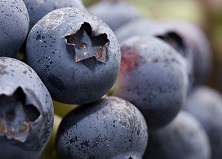
Blueberries in Florida: there is more to this little fruit than you think! July is National Blueberry Month and this little fruit gem, packed with health benefits, is considered one of the most nutrient dense foods in the world.
In one cup of blueberries you can find:
- 4 grams of fiber that can decrease the risk of heart disease and lower the amount of cholesterol in the blood
- High percentages of daily recommended vitamins (Vitamin K-36%, Vitamin C-25%, hManganese-25%, Copper-9% plus over 80 more nutrients)
- Antioxidants, especially proanthocyanidins which reduce and reverse inflammation
- Phenols, like gallic acid(also known as an antifungal/antiviral agent), that protect the brain from oxidative stress and degeneration
- With only 84 calories (per cup) it has a very low glycemic index and can aid in diabetic management and weight loss

Adding blueberries to your diet can also help maintain healthy bones, lower blood pressure, improve mental health and possibly combat cancer. With so many health benefits to eating blueberries it make sense to take advantage of the growing season for Florida blueberries (May-August) and stock up on them as much as possible.
Blueberries are a member of the Ericaceae family and are related to the rhododendron, azalea, cranberry and huckleberry. Although blueberries are native to the U.S., it was not until the early 1900’s when wild blueberries were first bred for cultivar improvement. In the natural areas of Florida, there are at least eight wild species including the evergreen blueberry (Vaccinium darrowii), and they can be found throughout the state except where pH’s are above 7.0. Two types of commercial blueberries grow in Florida, low chill cultivars of both southern highbush (Vaccinium spp.) and rabbiteye (Vaccinium virgatum). Rabbiteye grows best in areas that have cooler winters than those found in Ocala and highbush can grow best between Sebring and Ocala with 2014 research suggesting there might be new genotypes that can be productive further south.
Even though Indian River County is not known for growing blueberries, it does not mean that it can’t be done. In fact, some intrepid spirits have already attempted to grow blueberries in our area but, unfortunately, the fruit is not commercially available yet. There are two main challenges with growing blueberries in our area; one problem is the lack of chill hours and another is soil pH. Until fairly recently, blueberries could not be grown in our area because they need a certain number of chill hours in order to be productive. Chill hours are the number of hours needed at or below 45 degrees throughout the winter in order to produce spring growth. Previously, most blueberry varieties needed 300-500 chill hours, but due to research at the University of Florida and Georgia, there are now some varieties that can produce berries with less than 150 chill hours and under certain conditions, might grow as far south as Arcadia. Indian River County receives between 110 and 210 chill hours during the winter so the best varieties right now would ‘Sapphire’ and ‘Jewel’ with the lowest chill requirements.
Soil pH is another factor to consider when growing blueberries in Florida; acidic soils with low pH’s are more conducive to blueberry production. Most of the soils east of I-95 in Indian River County are very high and alkaline due to its proximity to the coast and a millennium of sea fluctuations that covered the mainland with sand and shells. West of I-95, the pH’s are lower due to previous citrus production activity or the native ecosystem being pine-palmetto flatwoods. Since blueberries grow best in pH’s between 4.0 and 5.3, it is very important to have a soil sample analysis done before planting to determine if the pH is adequate for production. Soil amendments can be added to lower the pH, but it will need to be checked every few years to make sure that the pH stays at a level that is sufficient for blueberry plants to grow and produce fruit. Soil pH can be determined in the Indian River County Extension office, but a more complete nutritional soil analysis will have to be done at the UF/IFAS Extension Soils Testing Lab in Gainesville. If you decide to plant blueberries, don’t forget to contact the extension office for more information and assistance.
Other resources:
Florida Blueberry Growers Association http://floridablueberrygrowers.com/
UF/IFAS EDIS Blueberry website http://edis.ifas.ufl.edu/topic_blueberry
 0
0
